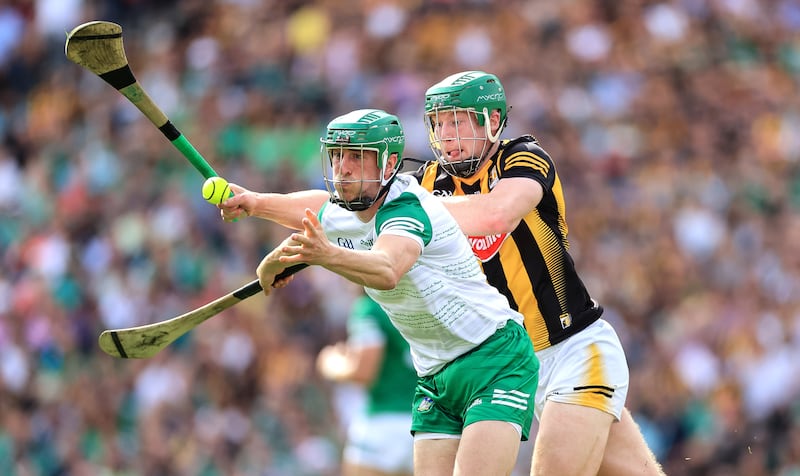Watching Limerick on Sunday, it was clear that they are a team that timed their run through the season perfectly. They won an All-Ireland by being ready to meet exactly the challenges they needed to at exactly the time they had to. They got the absolute best out of themselves when it mattered most. That’s not an easy thing to do.
To get there, they had to go their own way about planning their season. The league is irrelevant, never more so than this year. Think about it this way — the team that won the league doesn’t even have a manager today. Liam Cahill is already in the Tipperary job, even after winning silverware with Waterford four months ago. That will tell you how much the league matters in the scheme of things.
Limerick did nothing in the league. So much so that by the end of it, people were asking questions about them. Most people suspected that it meant nothing but you still heard the odd suspicion here and there. Would they be able to just flick a switch? Was their discipline a problem? Were they coming back to the pack?
[ Nicky English: Limerick show exceptional desire to take a first three-in-a-rowOpens in new window ]
[ Tipping Point: Limerick’s resilience has changed the way they think of themselvesOpens in new window ]
We got our answers in the championship. This All-Ireland proves that early season form means nothing. Limerick won one match in the league — against Offaly, who finished the summer coming fourth in the Joe McDonagh table. But when it came to championship, Limerick played all the Munster counties and the best two teams in Leinster and beat them all. They picked up their share of injuries and suspensions along the way and still nobody could beat them. They are brilliant All-Ireland champions.
Five Things We Learned from GAA Weekend: FRC have done a lot right but some rules need binning
Alarm bells are ringing about GAA hooters - good thing there’s an easy solution
Ireland v France: What time is kick-off and what TV channel is it on?
Who is Clayton McMillan and what can Munster fans expect from new coach?
After Sunday, I came away even more convinced that the day to catch them was the semi-final. Galway disrupted their flow and got them out of their rhythm. They had a real chance to beat them down the stretch, something I don’t think Kilkenny had on Sunday, even though they put in a huge performance. It was a great game but I never felt at any stage that Limerick were in danger of losing it.
Limerick’s reaction when Richie Hogan scored his equaliser with seven minutes to go told you everything. I’d say everyone in the ground and watching on TV had the same thought — this is set up for Richie now, a fairy-tale ending off the bench. But Limerick never let him into the game again.
Instead what happened was they just took total control of the game for the next seven minutes. Tom Morrissey and Kyle Hayes combined to score from the puck-out after Richie’s point. Diarmaid Byrnes came out with the ball from the next Kilkenny attack and Cathal O’Neill scored with his first touch off the bench. Limerick scored five points in a row and sealed the match.
When you really examine what was the key to that crucial period of the game, it came down to two specific things — wanting the ball and winning it cleanly. Those are the two factors that allow you to dominate a period of hurling. Desire and technique. Everything else flows from them.
It starts with wanting the ball. Not just making the run — we’ve all seen players making runs but the last thing they want is the actual ball. Watch Limerick in those closing stages — their big players in the half-forward line were all still making those runs that pushed them into the lead early in the game. Their body language was screaming: Get me the ball, I want it.

Once you have the first part, the second part needs to be spot on too. In the closing stages of an All-Ireland final, when the tension is so high and the bodies are starting to run on empty, clean ball makes all the difference in the world. A tired defender gets a spurt of energy if he lunges and deflects the ball away from you in that moment. But if you take it clean, it’s another little drain on him. And if you score, he just feels more tired again.
That’s what really stood out as Limerick managed those minutes after the Kilkenny equaliser. Cathal O’Neill and Conor Boylan were only fresh in off the bench but both of them showed for ball as Limerick came out of defence and their technique was perfect — both hit long-range points after slipping away from tired defenders. Limerick in that period combined all the things you need — skill, physicality, speed, confidence.
By that stage, there wasn’t a lot Kilkenny could do. It was some effort from them to get back into the game but realistically, the damage was done in the first half. I couldn’t believe how much space they allowed the Limerick half-forward line to operate in, especially from Nickie Quaid’s puck-outs.
Kilkenny were brave. They sent TJ Reid in on Barry Nash and pushed right up, meaning Quaid generally had to go long with his puck-outs. Very few teams do that against Limerick any more. On one level, it worked very well. Nash wasn’t able to distribute as much clean ball as he usually is and the knock-on effect was that Aaron Gillane, Séamie Flanagan and Graeme Mulcahy all had pretty quiet afternoons by their standards.
But the Limerick half-forward line did all the damage instead. I couldn’t understand how passive the Kilkenny half-back line were on them. I know Hegarty, Hayes and Morrissey were making lots of runs and moving very intelligently to get into space but as far as I could see, not a finger was being laid on them.
At that level in an All-Ireland final, you have to annoy them. You have to get physical, check their runs, irritate them. I’m not saying you have to foul them but you have to make it far less comfortable for them than it was. Hegarty and Hayes were never having to wriggle free of their marker to get on the ball — they were able to cross over and run into space without anybody standing in their way.
It was very unlike Kilkenny. If anything, they were a bit too nice at times. I couldn’t really understand why. Limerick’s most important line were able to dictate terms. Kilkenny went man-for-man on them, which I felt was the right thing to do. But they didn’t mark them tightly enough. It should have been a frustrating experience for the Limerick half-forward line. Instead, they were free to go where they pleased.
Four All-Irelands in five years is some achievement. You can see the unity they have and the sense of trust they have in each other. Some of them have been playing together since they were under-14 — that belief they have in each other comes from years of knowing who they are and how they react to every kind of situation.
As much as anything, that’s what allows them to treat the league as an irrelevance. They don’t need to use it as a stepping stone in the way some other teams might have to. I’m not even completely sure they really need to win Munster any more. All they really need out of it is one or two good tests to let them know where they are.

In that respect, I think the game in Ennis against Clare in the Munster round-robin back in May was arguably as big a performance as they had outside the All-Ireland final. They went to play in a jam-packed Cusack Park without Cian Lynch, Aaron Gillane and Darragh O’Donovan. Plus, they had been in the news during the week after John Kiely dropped a panel member because of a row in a pub. If they were ever vulnerable, it should have been that day.
But they didn’t lose. Clare threw everything at them and still couldn’t beat them. And, even better for Limerick, people in Clare seemed to come away from that game delighted with the result. They weren’t downhearted at not having beaten such a weakened Limerick team. That would have told John Kiely and Paul Kinnerk so much about where they stood, probably even more so than the Munster final.
They end the year on top and not looking like they’re ready to go anywhere. It’s up to the other counties to get up to their level. It might look impossible after they’ve won four out of five All-Irelands but I actually think there’s a few chinks of light for everyone else to take encouragement from.
Limerick are champions but they had to fight for every inch of it. They didn’t blow teams out of the water this year like they did in 2020 and 2021. They beat Galway by three points and Kilkenny by two. Clare pushed them to extra-time in the Munster final. All three of those teams will go into next year convinced they’re not too far away. A few others will be thinking, “Well, if Galway, Kilkenny and Clare aren’t too far away, then neither are we.”
For now, Limerick’s age-profile is still on the right side of where they need it to be. Of their outfield starters on Sunday, only Graeme Mulcahy is over 30. Declan Hannon and Dan Morrissey are 29 and everybody else is younger again. But at the same time, it’s starting to tick upwards — Kyle Hayes was their youngest starter on Sunday and he’ll be 25 next year. Will Kiely decide they need to start freshening up as they go?
They will lose eventually, obviously. Nothing goes on forever. The upside for lots of the other counties is that plenty of them are at a similar level. A lot of counties will feel that they underachieved in 2022 and so they will head into the off-season with plenty of areas to improve on. There’s no obvious favourite for who will emerge from the pack to challenge Limerick in 2023. It’s reachable for everyone.
There’s something to be said for being around at the same time as such a great team. It gives you a target to aim at. If I was still playing now, I’d be trying to do everything in my power to get up to their level. You have to question everything. Keep working, keep striving, feel the pain of defeat and keep moving on with it.
That’s all you can do. It’s hard right now to pick out exactly who will stop Limerick, or when. But someone will. And maybe sooner than we think.

















